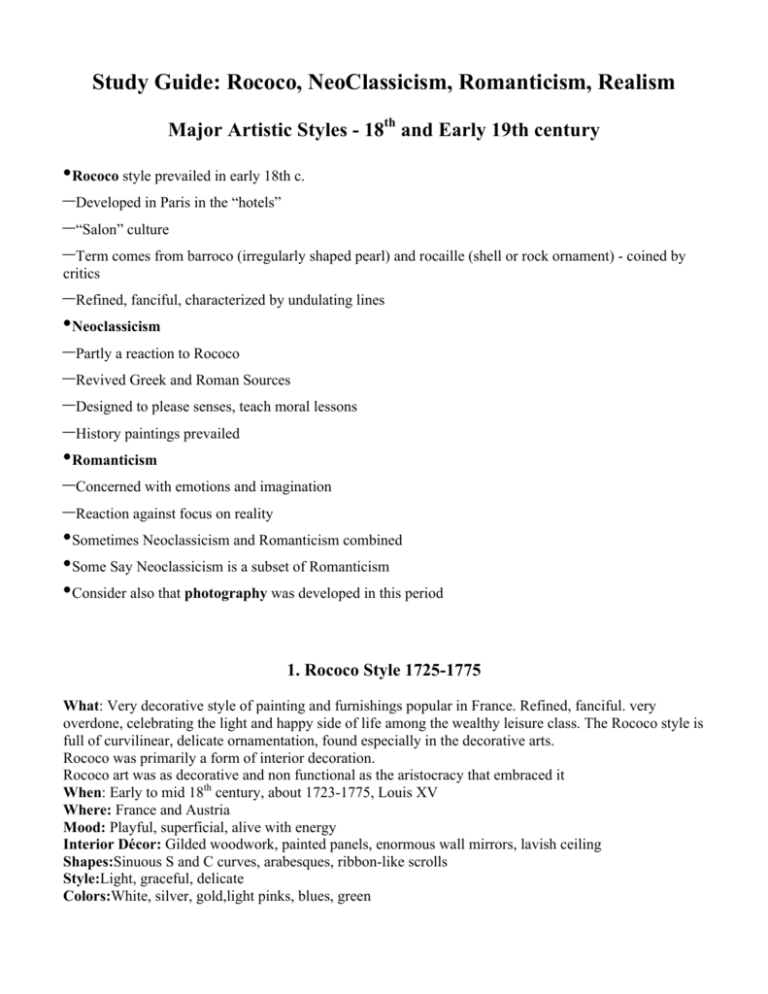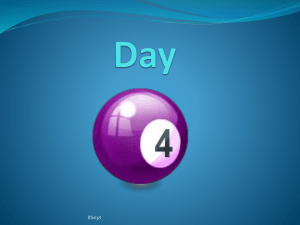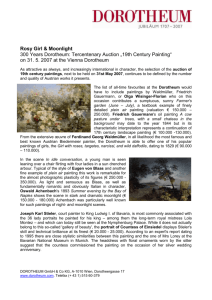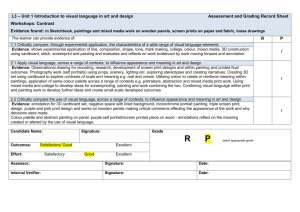Study Guide: Rococo, NeoClassicism, Romanticism
advertisement

Study Guide: Rococo, NeoClassicism, Romanticism, Realism Major Artistic Styles - 18th and Early 19th century •Rococo style prevailed in early 18th c. –Developed in Paris in the “hotels” –“Salon” culture –Term comes from barroco (irregularly shaped pearl) and rocaille (shell or rock ornament) - coined by critics –Refined, fanciful, characterized by undulating lines •Neoclassicism –Partly a reaction to Rococo –Revived Greek and Roman Sources –Designed to please senses, teach moral lessons –History paintings prevailed •Romanticism –Concerned with emotions and imagination –Reaction against focus on reality •Sometimes Neoclassicism and Romanticism combined •Some Say Neoclassicism is a subset of Romanticism •Consider also that photography was developed in this period 1. Rococo Style 1725-1775 What: Very decorative style of painting and furnishings popular in France. Refined, fanciful. very overdone, celebrating the light and happy side of life among the wealthy leisure class. The Rococo style is full of curvilinear, delicate ornamentation, found especially in the decorative arts. Rococo was primarily a form of interior decoration. Rococo art was as decorative and non functional as the aristocracy that embraced it When: Early to mid 18th century, about 1723-1775, Louis XV Where: France and Austria Mood: Playful, superficial, alive with energy Interior Décor: Gilded woodwork, painted panels, enormous wall mirrors, lavish ceiling Shapes:Sinuous S and C curves, arabesques, ribbon-like scrolls Style:Light, graceful, delicate Colors:White, silver, gold,light pinks, blues, green Architecture • Residenz, Austria designed by Johann Neumann § Imperial Hall at the Residenz § Ceilings painted by Italian Painter Tiepolo § Church of Vierezhnheiligen, Neumann Painting: There was less of an interest in weighty religious and historical subjects (although these were never ignored completely) as artists began to create more intimate mythological scenes, views of daily life, and portraiture. Watteau: Work epitomizes the French Rococo Style. He created a new style of painting called the fete galante, or elegant outdoor entertainment. § Pilgrimage to Cythera, § The Signboard of Gersaint Boucher: Best known for his mythological scenes where gods and goddesses, largely nude, frolic or relax in pastoral settings § Diana Resting after her Bath § The Toilet of Venus Fragonard: Student of Boucher and an accomplished painter in his own right. rs. The Swing The Confession of Love Clodion:Sculptor Nymph and Satyr The ANTI ROCOCO artists: Grueze The Village Bride Chardin Grace at Table Still Life with Pipe and Jug Vigee-LeBrun Self Portrait with Two Pupils Hogarth The Marriage Contract The Orgy English Portrait Painting Gainsborough The Blue Boy Mr. and Mrs. Andrew Reynolds Portrait of Lady Sarah Bunbury The Grand Tour Canaletto Piazza San Marco with the Basilica Palazzo Ducale and the Piazza di San Marco Beginning of a Classical Revival Piranesi Arch of Drusus 2. Neoclassical c. 1750-1850 Why a revival of Classicism? Enlightenment emphasis on rationality Greece and Rome seen as models of enlightened political organization Especially appealing during the French and American Revolutions The discovery and excavation of Herculaneum and Pompeii Arrival of Elgin Marbles in England, 1806 Grand Tour also played a role •VALUES: Order solemnity •TONE: Calm, rational •SUBJECTS: Greek and Roman history, mythology •TECHNIQUE: Stressed drawing with lines, not color no trace of brushwork •ROLE OF ART: Morally uplifting, inspirational Early Neo Classicism Raphael Mengs, German painter working in Itlay • Parnassus, ceiling fresco in Villa Albani, Rome, 1761 Antonio Canova The epitome of the neoclassical sculptor, his work marked a return to classical refinement after the theatrical excesses of Baroque sculpture • Cupid and Psyche • Pauline Borghese as Venus • The Three Graces Angelica Kauffmann Swiss born painter who worked extensively in England and Italy • Cornelia Presenting Her Children as her Treasures • Return of Telemachus Benjamin West American-born painter of historical, religious, and mythological subjects who had a profound influence on the development of historical painting in Britain. • Agrippina Landing at Brundisium with the Ashes of Germanicus • The Death of General Wolfe • Penn's Treaty with the Indians Neoclassical Architecture in Britain Britain during the mid 18th c. saw a reaction against Baroque + a return to Classical Palladian Boyle and Kent, Chiswick House, London Early Georgian John Wood the Younger, The Royal Crescent, Bath, England Late Georgian French Neo Classical Artists: THE BIG BOYS Jacques-Louis David David was a highly influential French painter in the Neoclassical style, considered to be the prominent painter of the era. In the 1780s his thoughtful, serious style of history painting marked a change in taste away from Rococo frivolity towards classical austerity and severity • The Oath of the Horatii • The Death of Socrates • The Death of Marat • Jean Auguste Dominique Ingres Strong supporter of the Neoclassical style, especially when under the attack of the “barbarian Romantic” painters of the mid 19th century. However, at times Ingres work strayed from typical Classical scenes to more erotic and exotic subject matter. • The Grand Odalisque • Odalisque with a Slave • Princess de Broglie French Neoclassical Architecture Jacques-Germain Soufflot The Pantheon, Sainte Genevieve, Paris, 1755-1792 Pierre Vignon La Madeleine, Paris, 1807-1842 18th Century Art In the United States Thomas Jefferson Montecello Virginia State Capitol Jean Antoine Houdon Statue of George Washington 3. Romanticism • • • • • An art movement and style that flourished in the early nineteenth century. It emphasized emotions painted in a bold, dramatic manner. Romantic artists rejected the cool reasoning of classicism the established art of the times to paint pictures of nature in its untamed state, or other exotic settings filled with dramatic action, often with an emphasis on the past. It was also to some extent a reaction against the Enlightenment and against 18th-century rationalism and physical materialism in general. Romanticism emphasized the individual, the subjective, the irrational, the imaginative, the personal, the spontaneous, the emotional, the visionary, and the transcendental. VALUES: Intuition, Emotion, Imagination INSPIRATION: Medieval and Baroque eras, Middle and Far East TONE: Subjective, Spontaneous, Nonconformist COLOR: Unrestrained, Deep, Rich Shades Early Romantic Painting in England Henry Fuseli • The Nightmare, 1781 William Blake • The Ancient of Days Romantic Painting in France In France the formative stage of romanticism coincided with the Napoleonic Wars (1799-1815), and the first French romantic painters found their inspiration in contemporary events. Antoine Jean Gros • Napoleon Bonaparte Visiting the Plague-stricken at Jaffa Theodore Gericault He carried further the dramatic, coloristic tendencies of Gros's style and shifted the emphasis of battle paintings from heroism to suffering and endurance. • Wounded Cuirassier (1814 • The Raft of the Medusa Eugene Delacroix • The Massacre at Chios • The Death of Sardanapal • Liberty Leading the People • The Women of Algiers • Odalisque Spanish Romantic Painting Francesco Goya Some scholars place Goya in the Romantic period, whereas others believe he fits in no specific category. • Goya was a life long rebel, fiercely opposed to tyranny of all sorts Charles IV and his Family • The Nude Maja (La Maja Desnuda) • The Third of May, 1808: The Execution of the Defenders of Madrid • Saturn Devouring One of his Children Romantic Landscape Painting Romantic Painting in England In England the Romantic tradition began in the early 19th century with Henry Fuseli and William Blake, and culminated with Joseph M. W. Turner and John Constable. English painters like Constable and Turner lifted the status of landscape painting by giving natural scenes heroic overtones. Turner and Constable did more than anyone to establish landscape painting as a major genre. Yet, stylistically JMW Turner and John Constable could not have been more different. Constable made nature his subject, while Turner’s subjects were color and atmosphere. Constable painted placid scenes of the actual countryside, often working from life. Turner’s turbulent seascapes and storms existed mainly in his imagination. John Constable • The Hay-Wain • The Stour-Valley with the Church of Dedham • View of Salisbury • Salisbury Cathedral from the Bishop's Grounds JMW Turner • Fishermen at Sea • The Grand Canal, Venice • The Burning of the Houses of Lords and Commons • The Slave Ship • Rain, Steam and Speed The Great Western Railway American Romanticism Romantic painting in America encompasses two subjects: nature and the natural man. The former were landscape paintings and the later were ordinary people engaged in ordinary activities. In both cases, the subjects were seen through rose-colored glasses. Thomas Cole • The Hunter’s Return • The Oxbow George Caleb Bingham • Fur traders on Missouri River John James Audubon • Hooping Crane George Catlin • Buffalo Bull's Back Fat 4. Realism • The new realism of the 19th century, insisted on precise imitations of visual perceptions without alterations. Like Roman portrait sculpture, there was no room for idealization. • French Realism was a reaction to the work of the French Romantic artists. • Realists believed that “painting is a concrete art and must be applied to real and existing things” • History paintings, poetic subjects, gods and goddesses were not considered suitable subjects. • Peasants and working class citizens were the new subjects for painting. Honore Daumier Great caricaturist Known for his political cartoons and drawings about French society • Transnonain Street. 1834. Lithography • The Third-Class Carriage. Gustave Courbet Courbet believed that if an artist could not see his subject, he could not paint it. Courbet loudly defended the lower classes whom he often painted and was jailed for six months for tearing down a statue of Napoleon. • The Burial at Ornans • The Painter's Studio; A Real Allegory The Barbizon School Inspired by Constable’s style of painting outdoors, a group of French painters known as the Barbizon School, for a village nearby, brought the same freshness to French landscape painting. Camille Corot He brought a natural objective style to landscape painting, capturing the quality of a particular place at a particular moment. Corot used a limited palette of pearly silver tones with olive green and soft wispy brush strokes. He was widely admired by the Impressionist painters who followed him. • View from the Farnese Gardens, Rome • Souvenir of a Meadow at Brunoy • Ville de Avray. (c. 1867). Jean Francois Millet He is best known for his paintings of rural laborers working in the fields. In his paintings the peasants are portrayed with honest dignity. • The Gleaners • Evening Prayer • The Sower British Painting: The Pre-Raphalites The Pre-Raphaelites have been considered the first avant-garde movement in art, though they have also been denied that status, because they continued to accept both the concepts of history painting and the imitation of nature, as central to the purpose of art. Dante Gabriel Rossetti • The Annunciation • The Day Dream. Realism in America Winslow Homer A self taught artist, Homer steered away from outside influence and art theories. Based his work on careful direct observation of nature. His skill made him the major marine painter and watercolorist of all time. • Croquet, 1864 • Snap the Whip • Breezing Up Thomas Eakins Eakins was a painter and an uncompromising realist. His main concern in his paintings was to get the anatomy right. To learn anatomy, he dissected cadavers and became so knowledgable on the subject that he lectured to medical students. • Max Schmitt in a single scull • The Gross Clinic James McNeill Whistler Whistler was one of the most controversial artists of the 19th century, who strongly believed in the “art for art’s sake” theory. He believed first and foremost that a painting was a blank surface covered with colors and varying patterns. His portraits, landscape and still lifes were less representations of the subject and more experiments in design. • • • • • The Artist's Studio. Symphony in White No. 1: The White Girl. Arrangement in Gray and Black No. 1: Portrait of the Artist's Mother Nocturne in Blue and Gold - Old Battersea Bridge. Nocturne in Black and Gold: The Falling Rocket. John Singer Sargent Sargent was the last great literal portrait painter before photography became widely used. He was truly an international figure, he was once described as, “An American born in Italy, educated in France, who looks like a German, speaks like an Englishman and paints like a Spaniard. Although he was a friend of Monet’s and painted with him, Sargent modeled himself after Velasquez. • • • • Mr. and Mrs. I. N. Phelps Stokes Madame X The Daughters of Edward Darley Boit Carnation, Lily, Lily, Rose Vocab: o o o o o o o o o Rococo Fete galante Grand Manner Portrait Grand Tour Neo-classicism Palladianism Georgian Style History painting Romanticism







